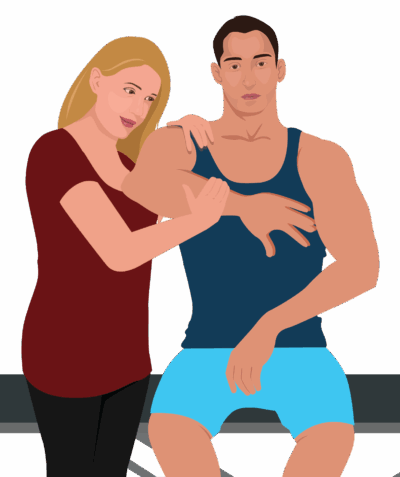Hawkins-Kennedy Test
The Hawkins-Kennedy Test is a commonly used orthopedic assessment for subacromial impingement syndrome (shoulder impingement). It is designed to provoke impingement of the rotator cuff tendons (especially supraspinatus) and the subacromial bursa beneath the acromion.
How the Test is Performed
-
Client Position: Seated or standing with arms relaxed.
-
The examiner passively flexes the client’s shoulder to 90°, with the elbow also bent to 90°.
-
While stabilizing the shoulder and the elbow, the examiner briskly or smoothly passively internally rotates the shoulder (brings the forearm and hand down, rotating the humerus).
-
A positive test is the reproduction of pain, typically in the anterior or lateral shoulder as the movement brings the greater tuberosity into contact with the coracoacromial arch, squeezing the subacromial soft tissues.
Clinical Significance
-
A positive Hawkins-Kennedy Test strongly suggests subacromial impingement of the rotator cuff tendons, especially if combined with other positive impingement signs (e.g., Neer, painful arc).
-
Sensitivity is relatively high (around 80%), so a negative result helps rule out impingement, but the specificity is only moderate. A positive could result from other pathologies, such as AC arthrosis or labral tears.
Assessment
-
Use this test with clients presenting with shoulder pain, especially if aggravated by overhead movement or rotation.
-
Note the onset, location, and quality of pain, and if combined with other positive impingement findings, document for clinical reasoning and interprofessional referral.
-
Track test response over the course of treatment to monitor change.
Treatment
-
If impingement is indicated, avoid deep or aggressive work over the subacromial space, front of the shoulder, or rotator cuff tendons to prevent symptom exacerbation.
-
Focus on gentle myofascial release, scapular stabilization, postural education, and soft tissue work to the compensating muscles (upper back, posterior capsule, pecs).
-
Educate clients about avoiding provocative positions until symptoms are improved and reinforce the need for appropriate exercise or rehab.
Safety and Referral
-
Acute, severe, or persistent pain with positive Hawkins-Kennedy Test requires referral to a physician or physiotherapist to rule out significant rotator cuff tear, bursitis, or labral pathology.
-
Avoid performing repeated impingement maneuvers if there is intense pain or loss of active motion.

